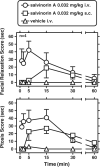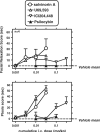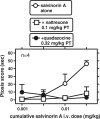The discriminative effects of the kappa-opioid hallucinogen salvinorin A in nonhuman primates: dissociation from classic hallucinogen effects
- PMID: 20084367
- PMCID: PMC2866021
- DOI: 10.1007/s00213-009-1771-5
The discriminative effects of the kappa-opioid hallucinogen salvinorin A in nonhuman primates: dissociation from classic hallucinogen effects
Abstract
Rationale: The widely available hallucinogen salvinorin A is a unique example of a plant-derived compound selective for kappa-opioid receptors and may produce effects distinct from those of other compounds with classic hallucinogenic or dissociative properties which are also abused in humans.
Objectives: The objective of this study is to characterize the salvinorin A discriminative cue in nonhuman primates with high kappa-receptor genetic homology to humans.
Methods: Adult rhesus monkeys (n = 3) were trained to discriminate salvinorin A (0.015 mg/kg, s.c.) from vehicle, in a food-reinforced operant discrimination assay. Parallel studies, using unconditioned behavioral endpoints (facial relaxation and ptosis) also evaluated the kappa-opioid receptor mediation of salvinorin A in vivo function.
Results: Monkeys trained to discriminate salvinorin A generalized structurally diverse, centrally penetrating kappa-agonists (bremazocine, U69,593, and U50,488). By contrast, mu- and delta-opioid agonists (fentanyl and SNC80, respectively) were not generalized, nor were the serotonergic 5HT2 hallucinogen psilocybin or the dissociative N-methyl-D-aspartic acid antagonist, ketamine. The discriminative effects of salvinorin A were blocked by the opioid antagonist quadazocine (0.32 mg/kg), but not by the 5HT2 antagonist ketanserin (0.1 mg/kg). Consistent with these findings, salvinorin and kappa-agonists (e.g., U69,593) produce effects in the unconditioned endpoints (e.g., ptosis), whereas psilocybin was inactive.
Conclusions: These findings support the conclusion that the interoceptive/discriminative cue produced by salvinorin A is mediated by agonism at kappa-receptors and is mechanistically distinct from that produced by a classic serotonergic hallucinogen.
Figures





Similar articles
-
Neuropharmacology of the naturally occurring kappa-opioid hallucinogen salvinorin A.Pharmacol Rev. 2011 Jun;63(2):316-47. doi: 10.1124/pr.110.003244. Epub 2011 Mar 28. Pharmacol Rev. 2011. PMID: 21444610 Free PMC article. Review.
-
The plant-derived hallucinogen, salvinorin A, produces kappa-opioid agonist-like discriminative effects in rhesus monkeys.Psychopharmacology (Berl). 2004 Mar;172(2):220-4. doi: 10.1007/s00213-003-1638-0. Epub 2003 Oct 30. Psychopharmacology (Berl). 2004. PMID: 14586540
-
Unconditioned behavioral effects of the powerful kappa-opioid hallucinogen salvinorin A in nonhuman primates: fast onset and entry into cerebrospinal fluid.J Pharmacol Exp Ther. 2009 Feb;328(2):588-97. doi: 10.1124/jpet.108.145342. Epub 2008 Nov 10. J Pharmacol Exp Ther. 2009. PMID: 19001155 Free PMC article.
-
Effects of salvinorin A, a kappa-opioid hallucinogen, on a neuroendocrine biomarker assay in nonhuman primates with high kappa-receptor homology to humans.J Pharmacol Exp Ther. 2007 Jan;320(1):300-6. doi: 10.1124/jpet.106.112417. Epub 2006 Oct 23. J Pharmacol Exp Ther. 2007. PMID: 17060493
-
Salvinorin A: the "magic mint" hallucinogen finds a molecular target in the kappa opioid receptor.Trends Pharmacol Sci. 2003 Mar;24(3):107-9. doi: 10.1016/S0165-6147(03)00027-0. Trends Pharmacol Sci. 2003. PMID: 12628350 Review.
Cited by
-
The dynorphin/κ-opioid receptor system and its role in psychiatric disorders.Cell Mol Life Sci. 2012 Mar;69(6):857-96. doi: 10.1007/s00018-011-0844-x. Epub 2011 Oct 16. Cell Mol Life Sci. 2012. PMID: 22002579 Free PMC article. Review.
-
Neuropharmacology of the naturally occurring kappa-opioid hallucinogen salvinorin A.Pharmacol Rev. 2011 Jun;63(2):316-47. doi: 10.1124/pr.110.003244. Epub 2011 Mar 28. Pharmacol Rev. 2011. PMID: 21444610 Free PMC article. Review.
-
The G-protein biased kappa opioid agonists, triazole 1.1 and nalfurafine, produce non-uniform behavioral effects in male rhesus monkeys.Pharmacol Biochem Behav. 2022 Jun;217:173394. doi: 10.1016/j.pbb.2022.173394. Epub 2022 May 2. Pharmacol Biochem Behav. 2022. PMID: 35513117 Free PMC article.
-
Neoclerodanes as atypical opioid receptor ligands.J Med Chem. 2013 May 9;56(9):3435-43. doi: 10.1021/jm400388u. Epub 2013 Apr 18. J Med Chem. 2013. PMID: 23548164 Free PMC article. Review.
-
A method for conducting functional MRI studies in alert nonhuman primates: initial results with opioid agonists in male cynomolgus monkeys.Exp Clin Psychopharmacol. 2013 Aug;21(4):323-31. doi: 10.1037/a0033062. Epub 2013 Jun 17. Exp Clin Psychopharmacol. 2013. PMID: 23773004 Free PMC article.
References
-
- Baker LE, Panos JJ, Killinger BA, Peet MM, Bell LM, Haliw LA, Walker SL. Comparison of the discriminative stimulus effects of salvinorin A and its derivatives to U69, 593 and U50, 488 in rats. Psychopharmacology. 2009;203:203–211. - PubMed
-
- Brandt MR, Negus SS, Mello NK, Furness MS, Zhang X, Rice KC. Discriminative stimulus effects of the nonpeptidic delta-opioid agonist SNC80 in rhesus monkeys. J Pharmacol Exp Ther. 1999;290:1157–1164. - PubMed
-
- Butelman ER, Harris TJ, Kreek MJ. Effects of E-2078, a stable dynorphin A(1–8) analog, on sedation and serum prolactin levels in rhesus monkeys. Psychopharmacology (Berl) 1999;147:73–80. - PubMed
-
- Butelman ER, Harris TJ, Kreek MJ. The plant-derived hallucinogen, salvinorin A, produces kappa-opioid agonist-like discriminative effects in rhesus monkeys. Psychopharmacology. 2004;172:220–224. - PubMed
-
- Butelman ER, Mandau M, Tidgewell K, Prisinzano TE, Yuferov V, Kreek MJ. Effects of salvinorin A, a kappa-opioid hallucinogen, on a neuroendocrine biomarker assay in non-human primates with high kappa-receptor homology to humans. J Pharmacol Exp Ther. 2007;320:300–306. - PubMed
Publication types
MeSH terms
Substances
Grants and funding
LinkOut - more resources
Full Text Sources
Other Literature Sources
Research Materials

